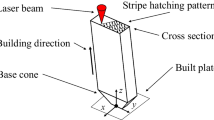Features of the deformation of sintered porous billets during orbital forging are considered. A schematic of an orbital forge with a roller as a punch is shown. To study orbital forging processes, cylindrical samples made of iron powder and its mixture with 1% of graphite compacted under 550, 700, and 850 MPa and sintered at 1150°C were used. The variation of the relative density and radial strain of billets during orbital forging with the axial strain and the variation of the strain with the shape factor of porous billets are described. It is shown that the total force of orbital forging is much lower (by a factor of 3.0–4.5) than the load needed to form similar billets by conventional free upsetting.








Similar content being viewed by others
References
L. T. Kryvda, Theory and Practice of Orbital Forging [in Ukrainian], Avanpost, Kiev (1998), p. 179.
I. S. Aliev and V. A. Matviichuk, “Development of local metal forming methods,” Obrab. Met. Davl., No. 1(19), 201–206 (2008).
V. A. Matviichuk and I. S. Aliev, Improvement of the Local Rotary Forming Processes Based on Analysis of the Deformability of Metals [in Russian], Donbass Gos. Mashinostr. Akad., Kramatorsk (2009), p. 268.
S. P. Gozhii, A. V. Klisko, and A. I. Nosenko, “Intensification of forming structural elements by orbital forging with active friction forces,” Visn. Nats. Tekh. Univer. “Khar. Polytekh. Inst. ,” Issue 45, 113–119 (2011).
G. A. Baglyuk, “Free upsetting of heated porous cylindrical specimens,” Powder Metall. Met. Ceram., 27, No. 7, 532–535 (1988).
V. A. Evstratov, Metal Forming Theory [in Russian], Vyshcha Shkola, Kiev (1981), p. 248.
H. A. Kuhn and B. L. Ferguson, Powder Forging, Metal Powder Industries Federation, Princeton, New Jersey (1990), p. 270.
R. Narayanasamy, V. Senthilkumar, and K. S. Pandey, “Some features on hot forging of powder metallurgy sintered high strength 4% titanium carbide composite steel preforms under different stress state conditions,” Mater. Design, No. 29, 1380–1400 (2008).
Yu. G. Dorofeev and V. V. Sinel’shchikov, “Strain and cracking behavior of preheated cylindrical powder blanks,” Powder Metall. Met. Ceram., 19, No. 1, 20–23 (1980).
Author information
Authors and Affiliations
Corresponding author
Additional information
Translated from Poroshkovaya Metallurgiya, Vol. 53, No. 9–10 (499), pp. 33–41, 2014.
Rights and permissions
About this article
Cite this article
Baglyuk, G.A., Kurikhin, V.G. & Gozhii, S.P. Orbital Forging of Sintered Porous Billets. Powder Metall Met Ceram 53, 522–528 (2015). https://doi.org/10.1007/s11106-015-9646-2
Received:
Published:
Issue Date:
DOI: https://doi.org/10.1007/s11106-015-9646-2




